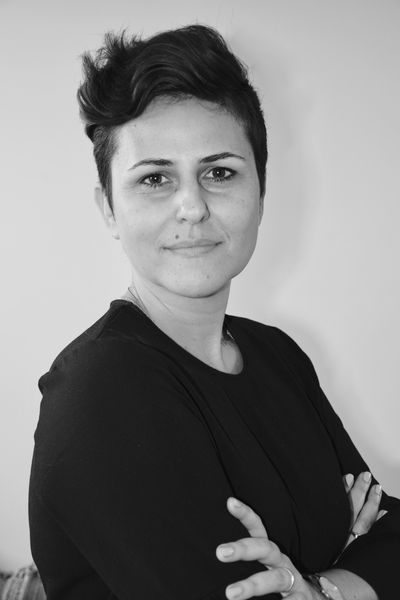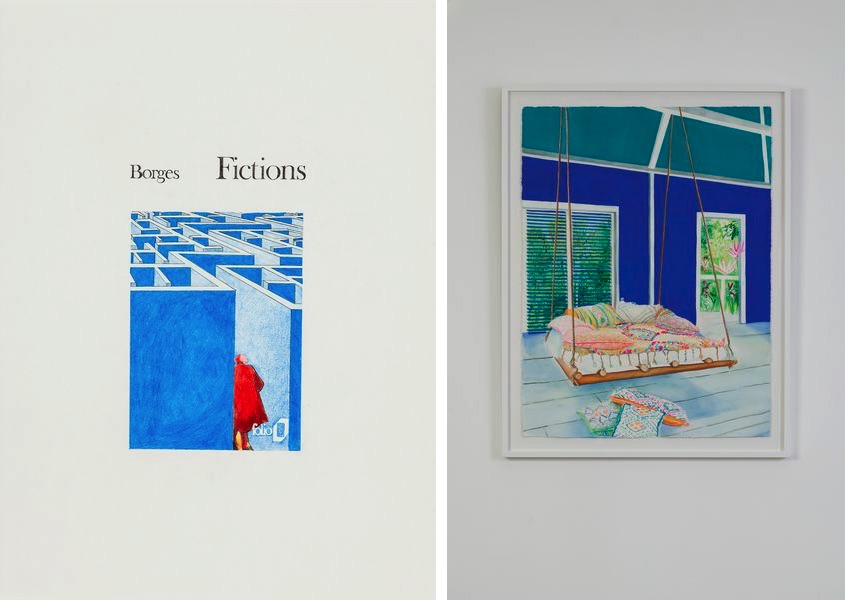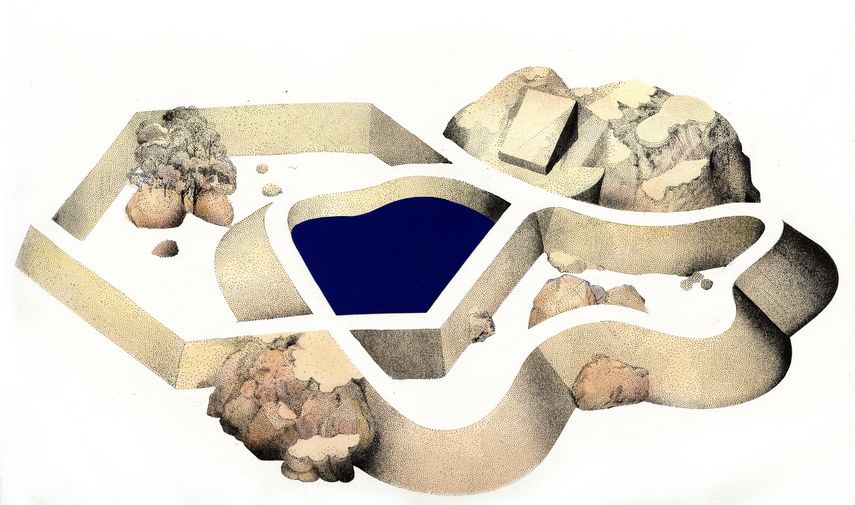[ad_1]
A fair dedicated to promoting contemporary drawing, DRAWING NOW Art Fair returns to Paris between March 22nd and March 25th, 2018 for its twelfth edition. An essential event during the Parisian artistic spring, the fair continues to reinforce the medium’s position in the contemporary art scene.
Taking place in the heart of the Marais neighborhood, at Le Carreau du Temple, the 2018 edition will bring together 72 local and international galleries, showcasing the best of drawing of the past 50 years. The fair will also present two new sectors – Process and Insight – that will feature around 20 galleries.
The exhibition program will be complemented with a variety of special projects and events, including an exhibition dedicated to comic book art, the month-long program of workshops, a series of talks and much more.
We had a chat with the International Artistic Director of the fair, Joana P.R. Neves, to find out what to expect at this year’s edition. In an exclusive Widewalls interview, Joana talks about the fair’s longevity, this year’s exhibitors, two new sectors, the accompanying project, the position of drawing in the contemporary art market, and much more.

DRAWING NOW Art Fair 2018
Widewalls: DRAWING NOW Art Fair returns to Paris this March for its 12th edition. What is the secret of its longevity and excellence?
Joana P.R. Neves: We are a relatively small but dedicated team with a long-term vision grounded in the sense of the contemporary. There is the word “now” in the fair which translates the mission of showcasing drawing in the present. To understand the present you must know the past and, conversely, to be able to foresee what will be the tendencies of the near future.
Categories are extendable to a certain degree and we need to root drawing in a precise way while still being able to follow its ramifications. We surround ourselves with people who can enlighten us and bring knowledge of art scenes we know less about.
Our independent committee is crucial in this sense: Véronique Souben (director of Frac Rouen) and Adam Budak (Chief Curator of the National Gallery of Prague) joined us this year; we are lucky to count on Daniel Schildge who brings the crucial perspective of the collector as well as Julie Enckell-Julliard (Director of the Musée Jenisch, Vevey) and Emilie Bouvard (curator and researcher at the Picasso Museum, Paris).
As the biggest art fair dedicated to drawing, we are keen on having international galleries and artists instead of restricting ourselves to a local scene. This year we welcome, for instance, the revered Anita Beckers gallery from Frankfurt, and the young gallery Catinca Tabacaru that has an original format: a New York commercial space and a residency in Harare, Zimbabwe.
While being a contemporary drawing art fair, we understand that collectors and institutional collections look simultaneously for history or tradition, and innovation. In one hand, the Masters Now circuit (a selection of twentieth drawing masterpieces until the 80’s by Philippe Piguet interspersed in the fair) is an elegant way to highlight drawing’s recent history. On the other hand, the Drawing Now Prize awarded every year to artists up to 45 years old rewards excellence and innovation: the artist who won last year, Lionel Sabatté, hardly had any works on paper in the fair – he uses dirt and hair, for example, to make his drawings which sometimes leads to volume.
The format is also important and helps visitors navigate the space and understand drawing in different ways. Without overcomplicating our structure, restricted by the specificities of the Carreau du Temple (our venue, in the center of Marais) we aim to promote a productive and complete visit – we even have kids’ workshops this year!
Collectors, curators, journalists, the general public are as passionate as we are and keep us on our toes.
Widewalls: This year, the fair will bring together 72 local and international galleries. Are there some highlights you would like to mention?
JN: I am happy to say that we have 28% new galleries of which two-thirds are in the new sectors, Process and Insight. I would highlight these new sectors with a diversity of proposals with galleries from Beijing to Montréal, not forgetting to mention that we have a small program of talks that provide a nice opportunity to complement the visit.
This year, we provide a particular focus on comics due to our collaboration with the Cité Internationale de la BD et de l’Image, a museum dedicated to comics with a magnificent collection. This year’s non-commercial exhibition will showcase cartoon artists and contemporary drawing, as a form of a dialogue between both practices that sometimes overlap. The curator of la Cité Internationale de la BD et de l’Image, Anne-Hélène Hoog will chat with a female Cartoon artist, Johanna Schipper.
We maintain our talks program dedicated to contemporary drawing nevertheless, with important curators and gallery directors such as Brett Littmann (Drawing Center NY), a great supporter of the fair, and Kate MacFarlane (co-founder and co-director of the Drawing Room in London) for instance as well as artists such as Hipkiss or Rebecca Salter.

New Sections and Projects at the Fair
Widewalls: This edition introduces two new sectors – Insight and Process. Could you tell us something about the concept of these sectors and the selection process behind them?
JN: The implementation of the two new sectors pertains to two aspects mentioned above: keeping up or even foresee the contemporary zeitgeist and provide fluidity to a multi-dimensional commercial venue such as an art fair.
Before, the fair was roughly structured between “young” or “emerging” galleries and established ones. This no longer mirrors the current gallery context. There is a wide array of excellent galleries which are no longer emerging but not yet in the central circuit. Moreover, a young gallery may represent an established artist whereas an established gallery might choose to take the risk of doing a solo show with an artist in the beginnings of his or her career.
There is a new tendency to evaluate artists’ careers as geographic, conceptual or disciplinary ramifications rather than the usual ladder of power formed by western museums based in big capitals and biennials. And drawing is a major symptom of that. Our collectors are drawn to us by the sheer passion of drawing’s capacity for experimentation and direct access to the artist’s mind.
Therefore, the new sectors, Insight and Process, were designed with that laboratory aspect in mind. Process showcases gallery proposals where the artists test the boundaries of drawing. Insight is the opportunity to immerse oneself in the universe of one or two artists not accessible in the Parisian art scene; the visitor thus gets a qualitative and complete experience of new work which is sometimes so hard to evaluate if the gallery only brings a single piece.
Widewalls: The exhibition program will be accompanied by an exciting program of special projects and events. What are the highlights of the program?
JN: As usual, we have our art circuit through the main galleries and museums in Paris: the Ricard Foundation, the Palais de Tokyo, the BnF (Bibliothèque Nationale de France) and many others.
Last year’s Drawing Now award winner will have a solo exhibition at Christie’s Paris, opening during the fair and the club Silentio (conceived by David Lynch) organizes a show with an artist shown repeatedly at the fair, Nina Fowler, in partnership with us.
Widewalls: Another novelty at the fair will be a Month of Drawing, a program dedicated to students, art schools and art enthusiasts. What are the planned activities during this month-long project?
JN: We have indeed initiated an exciting new project with the Ministry of Culture that may not be prominently visible but that fills us with joy nonetheless: March is now the month of drawing, which translates into a set of workshops with audiences that would not have a qualitative access to art.
These are organized with TRAM, the network of art centers in the Parisian area, selected artists and us. We provide an artistic experience to a wide range of audiences, from children to adults, through drawing.
The results of these workshops will be rendered public on the 22nd of March in the auditorium of the fair along with a talk moderated by Carine Tissot with guests involved in the project such as TRAM and the Centre Pompidou. Drawing is particularly prone to pedagogic experimentation and we are delighted to be able to be engaged in this operation.

Contemporary Drawing in the Art Market
Widewalls: How do you see the position of contemporary drawing in the contemporary art market? Who are the buyers and collectors of this medium?
JN: There are institutional and private collectors and the approach is obviously different. A private collector will have an ineffable and yet specific eye and the institutional curator will look to complete the collection according to its profile.
I personally find that when collecting drawing there are several attitudes: finding the secret of an artist’s oeuvre in one single sketch (I own a Matt Mullican drawing that could correspond to that!); developing a passion of the discipline; coming to it via other genres such as comics or photography since artists tend to develop their work in two or more media; and, finally, the collection around a specific movement, “school” or geographic area.
Drawing has the reputation of being affordable, which is true when you compare it to painting for instance, although there are some surprises to look out for. Thus, it tends to be the first purchase of a collection that may or may not expand to other areas.
Widewalls: How do you see the concept of the fair evolve in the future?
JN: There is always room for improvement! We will evaluate this new format and brainstorm in April to see what comes next. It’s dangerous to innovate or grow for the sake of it. Everything must be weighed down and feedback from galleries, collectors and visitors alike must be analyzed.
Featured image: Alfredo Barsuglia – Jasmin, 2014. Pencil on canvas, 105 x 147 cm © the artist. All images courtesy of DRAWING NOW Art Fair.
[ad_2]
Source link
